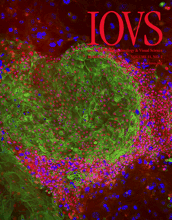L’eccesso di tessuto cicatriziale rappresenta uno degli eventi più importanti tra le cause di fallimento post operatorio (ostruzione al deflusso dell’umore acqueo) dopo chirurgia filtrante per glaucoma.
I fibroblasti sono le cellule che sono responsabili nella formazione del tessuto cicatriziale dopo trabeculectomia. L’aumento della vascolarizzazione in sede di bozza post intervento viene considerata uno dei target principali nell’impiego della terapia antifibroblastica (5-fluorouracile e mitomicina).
Scopo dello studio è valutare l’uso della terapia combinata con bevacizumab e 5-fluorouracile nel modulare la risposta postoperatoria cicatriziale dopo chirurgia filtrante per glaucoma.
Tale combinazione risulta infatti maggiormente efficace nel ridurre e modulare la cicatrizzazione rispetto alla monosomministrazione, evidenziando come il VEGF-A rappresenti un importante componente nel corso dell’evento ripartivo cicatriziale postchirurgico.
Alicia How; Jocelyn Leng Leng Chua; Amanda Charlton; Roseline Su; Marcus Lim; Rajesh S. Kumar; Jonathan G. Crowston; Tina T. Wong
Investigative Ophthalmology & Visual Science
February 2010
Purpose.: This study evaluated the use of combined bevacizumab with 5-fluorouracil (5-FU) on postoperative scarring and bleb survival after experimental glaucoma filtration surgery in comparison to the agents alone.
Methods.: Filtration surgery was performed on 26 female New Zealand White rabbits. The rabbits were allocated to one of four treatments: 5-FU combined with bevacizumab, 5-FU alone, bevacizumab alone, or phosphate buffered saline (PBS). The subconjunctival injections were administered immediate postoperatively and weekly for 3 weeks. Clinical assessment and bleb photography were performed. Histologic staining determined the presence of subconjunctvial fibrosis and mRNA expression of collagen I and fibronectin in the tissue was quantified.
Results.: Bevacizumab in combination with 5-FU resulted in a greater antifibrotic effect compared with monotherapy with 5-FU or bevacizumab alone, as evidenced by the attenuation in fibronectin and mature collagen I expression and deposition (P < 0.05). In addition, this was associated with a 100% bleb survival at day 28 in the combined treatment group compared with monotherapy (50% bevacizumab [P < 0.05] and 25% 5-FU [P < 0.001]). Conjunctival vascularity significantly reduced with bevacizumab treatment both alone and in combination with 5-FU.
Conclusions.: The results provide compelling evidence that combined bevacizumab and 5-FU offers superior antifibrotic effect over monotherapy in a model of glaucoma filtration surgery, while prolonging bleb survival at the same time. A synergistic effect is suggested to be present.

